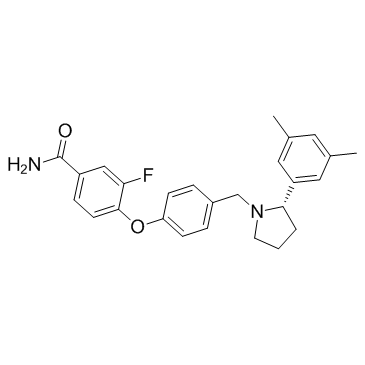1174130-61-0
| Name | 4-[4-[[(2S)-2-(3,5-dimethylphenyl)pyrrolidin-1-yl]methyl]phenoxy]-3-fluorobenzamide |
|---|---|
| Synonyms |
qc-359
unii-de4g8x55f5 jspa0658 (S)-4-(4-((2-(3,5-diMethylphenyl)pyrrolidin-1-yl)Methyl)phenoxy)-3-fluorobenzaMide LY-2456302 |
| Description | LY-2456302 is a potent and centrally-penetrant kappa opioid receptor antagonist with a Ki of 0.807 nM. |
|---|---|
| Related Catalog | |
| Target |
Ki: 0.807 nM (kappa opioid)[1] |
| In Vitro | LY2456302 binds with high affinity to the human kappa opioid receptor with a 30-fold higher affinity over the human mu opioid receptor and 190-fold higher affinity over the human delta opioid receptor. LY2456302 shows no appreciable affinity for several non-opioid cell surface G-protein-coupled receptor targets, including monoaminergic, muscarinic, cholinergic, and adrenergic receptors or ion channel/transporter binding targets or the central benzodiazepine binding site[1]. |
| In Vivo | LY2456302 has a rapid absorption (tmax=1-2 h) and good oral bioavailability (F=25%). Oral LY2456302 administration selectively and potently occupies central kappa opioid receptors (ED50=0.33 mg/kg), without evidence of mu or delta receptor occupancy. LY2456302 potently blocks kappa-agonist-mediated analgesia and disruption of prepulse inhibition, without affecting mu-agonist-mediated effects at doses >30-fold higher. LY2456302 produces antidepressant-like effects in the mouse forced swim test and enhances the effects of imipramine and citalopram. LY2456302 reduces ethanol self-administration in alcohol-preferring rats[1]. LY2456302 alleviates the nicotine withdrawal syndrome, as evidenced by decreased expression of nicotine withdrawal induced anxiety-related behavior, somatic signs, and CPA, and increased hotplate latency in nicotine withdrawn mice following pre-treatment[2]. |
| Kinase Assay | Radioligand displacement studies with [3H]diprenorphine are carried out using membranes prepared from CHO cells expressing cloned human κ and μ opioid receptors or HEK293 cells expressing the cloned δ opioid receptor. Concentrations causing 50% inhibition of [3H]-diprenorphine binding are determined from 11-point concentration response curves in assay buffer containing sodium and guanosine diphosphate (GDP). Naltrexone is included as a control at 10 μM to define nonspecific binding and is also tested as a comparator molecule in concentration response curves[1]. |
| Animal Admin | Rats: Three male cannulated rats are administered a single 1 mg/kg intravenous (IV) and 10 mg/kg oral (PO) dose of LY2456302 to determine the pharmacokinetic parameters. Plasma samples are collected at 0.08 (IV only), 0.25, 0.5, 1, 2, 4, 8, 12 and 24 h post-dose and analyzed by liquid chromatography coupled to tandem mass spectral detection to determine the concentrations of LY2456302[1]. Mice: Male mice are administered a single 10 mg/kg PO dose of LY2456302 to determine the pharmacokinetic parameters. Plasma samples are collected at 0.5, 1, 2, 4, 8, and 24 h post-dose and analyzed by LCeMS/MS to determine the concentrations of LY2456302. The plasma and brain binding of LY2456302 is determined by equilibrium dialysis at 1 μM[1]. |
| References |
| Molecular Formula | C26H27FN2O2 |
|---|---|
| Molecular Weight | 418.50300 |
| Exact Mass | 418.20600 |
| PSA | 56.55000 |
| LogP | 6.49290 |
